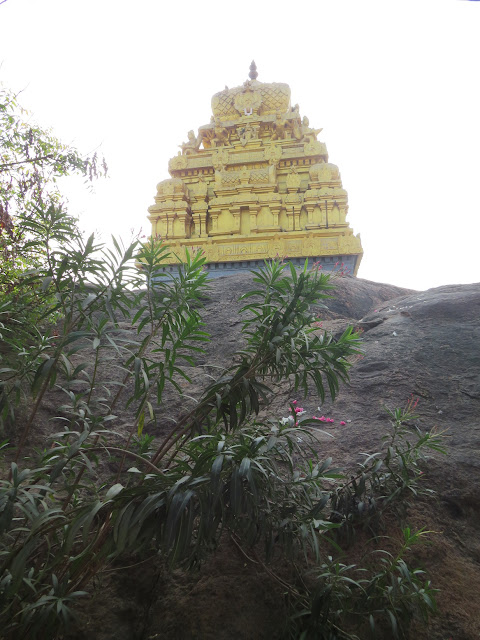Singa Perumal
What a majestic look! Such a magnificent image! Literally, we cannot take off our eyes from him. Even attaining moksha (liberation) is of no use, if one does not get an opportunity to visit this sacred shrine.
Singa Perumal - the unmatched Pataladri Narasimha - the savior of the universe named Narasinga Vinnagara Deva, is seated in the cave shrine. He holds chakra (discus) and sankha (conch) in his upper arms. His lower right arm is in abhaya mudra (protection). His lower left arm is bent at the wrist and is placed beneath his hip (called Kati mudra). He has a third eye on his forehead, which is unusual. His right knee is bent, resting on the seat. His left leg is stretched forward and rests on a lotus at the base. It is also an unusual feature. Typically Narasimha has his right leg hanging down and left leg bent.
The gigantic form of Narasimha tricks our eyes to believe that it is a stone icon. But, it is actually a stucco image.
There is no doubt that the Pallavas made the cave shrine. However, I doubt if Narasimha's icon is that old. I even wonder if the original structure was meant to be a Narasimha temple. Was this cell shrine used to install a later period Narasimha?
The replica of the presiding deity as a tiny stone icon is also found in the sanctum. It is a current-era image.
The bronze icons of Narasimha in the standing form named Prahala Varada with his consorts Sri Devi and Bhoo Devi and a seated Narasimha are situated here.
Multi-layers of Mandapas
The original cave shrine was extended with a multitude of mandapas. The contributions were made right from the Chola period through the 20th century CE.
There is a broad Maha mandapa in front of the cave shrine, possibly made by the Cholas. The entrance has stucco images of Dwarapalas (door guardians).
There is a Mukha mandapa, where the shrines of Ahobila Valli (the presiding Goddess) and Andal are situated. Both these shrines face east direction. They appear to have been built during the Vijayanagara period.
In front of Mukha mandapa, there is another mandapa. The south-facing shrine in this mandapa enshrines Ramanuja, Manavala Mamunigal, Periyalvar, Nammalvar, Tirumangai Alvar and Kulasekhara Alvar. Lakshmi Narasimha and Visvaksena are found along with the usual Garuda's shrine facing the sanctum. This mandapa has an opening in the south direction instead of the east.
In front of the south entrance of the above-mentioned Mukha mandapa, a 16-pillared mandapa is found. It was built in 1916 CE.
Other Structures
As stated earlier, Maha mandapa does not have an entrance in the east direction. Instead, Swarga Vasal or Paramapada entrance is located here.
In front of Swarga Vasal, there is a tall flagstaff (dhwajastambha), offering platform (bali peetha) and a lamp post (deepa stambha). A four-pillared mandapa, studded with many interesting sculptures is also situated here.
A small stucco image of Narasimha, a replica of the presiding deity, is found near the flagstaff.
There is a mandapa named Dwajarokona Mandapa located in the south corner.
Prakara
The prakara (circumambulatory) around the temple is a hillock that can be traversed through a flight of several steps. The vimana above the sanctum, called Pranavakoti vimana is visible only from here.
The holy tree of the site (sthala vruksha), Parijata, is located in this prakara. The stucco images of Lakshmi Narasimha and Tirupati Balaji are too found in the path.
Tower
The east-facing five-tiered gopuram (tower) has the sculptures of Visvaksena and Nagaraja in the inner entrance. Visvaksena is found with an elephant head and he holds sankha and chakra.
A Vijayanagara period four-pillared mandapa is situated in front of the tower. The pillars are studded with many beautiful sculptures that depict various forms of Vishnu.
Agama
The temple follows the religious rules as per Vaikanasa Agama.
Prasad
Like Tiruvallikkeni Parthasarathy Temple, the prasada stall in this temple is also famous for its varieties of food and taste.
Ranganatha Temple
Those who come to Singaperumal Koil, miss visiting a nearby Temple. In the Sannadhi Street, which is the street right in front of the tower, there is a Jeeyar Ashrama. Further inside the ashrama complex, there is a small south-facing temple for Ranganatha, with a gopuram (tower).
Ranganatha is found reclining on Adi Sesha, which is a usual pose. Lakshmi is found standing near the feet of Ranganatha, which is unusual. Typically, Ranganatha would have Sri Devi and Bhoo Devi at his feet; Brahma would emerge out of his nabhi (umbilical cord). They are missing here.
Garuda and Hanuman facing the main shrine and a stone icon of Narasimha are also found in the temple complex.
 |
| Jeeyar Mutt and Ranganatha Temple |
Bhakta Anjaneya
At the other end of Sannadhi Street, there is a shrine of Bhakta Anjaneya. Hanuman is found with his hands folded and faces the main temple. Although it is considered a separate temple nowadays, it is technically part of the Narasimha temple.
Suddha Pushkarani
Further away from Bhakta Anjaneya temple, a big holy tank named Suddha Pushkarani is located.
Happy travelling.


















.JPG)
Comments
Post a Comment